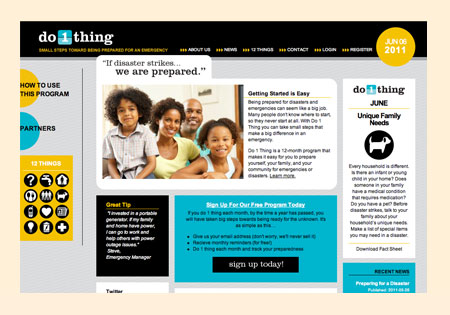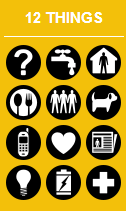You are here
Do 1 Thing in 2013
New Year’s resolutions have been on our mind at CDC’s Office of Public Health Preparedness and Response. Through the halls of CDC, you will hear talk of losing weight, reading more, spending less money… the list goes on and on. But let’s be honest, resolutions can be hard to keep. This year, make a resolution you can keep. Commit to improving your preparedness skills and resources for emergency situations.
The idea of preparing for an emergency may seem like a daunting task. Some shrug and assume that emergency responders will be there to save the day. The truth is, when disaster strikes, emergency responders are slammed with calls for help. It may be left up to you. Be ready and prepared to help yourself, your family, and your neighbors.
 Start small. Focus on one topic area each month for the year. The Office of Public Health Preparedness and Response has recognized the Do 1 Thing project as a community effort that reflects and embodies the Whole Community approach to emergency management. Do 1 Thing, a web-based preparedness program, encourages participants to become better prepared by tackling one topic each month.
Start small. Focus on one topic area each month for the year. The Office of Public Health Preparedness and Response has recognized the Do 1 Thing project as a community effort that reflects and embodies the Whole Community approach to emergency management. Do 1 Thing, a web-based preparedness program, encourages participants to become better prepared by tackling one topic each month.
We visited Lansing, Michigan in December to learn more about Do 1 Thing and met with the creative founders of the program, emergency management specialist Ronda Oberlin, program planner Erika Mahoney, and disaster services director Rachelle Wood. After witnessing people continuously fail to prepare for emergencies, they decided to research why people do not prepare: “People are overwhelmed by the process of becoming prepared. Being prepared for disasters and emergencies can seem like a big job,” says Oberlin. “Many people don't know where to start, so they never start at all.” Do 1 Thing was created to address these barriers by providing small steps in preparedness that can make a big difference in an emergency. People can jump in and start the program at any time.
Do 1 Thing focuses on a different aspect of preparedness each month. Do what you can. Each month, Do 1 Thing lists various ways you can tackle the monthly goal. Making an emergency plan is the first step for January. This can include where to shelter during a natural disaster, evacuation routes, designating a family meeting place outside the home, and where to meet up if your neighborhood is evacuated. Planning each step and practicing emergency drills will help you and your family be more confident when a real emergency occurs.

Steve Lehman of Clinton County Emergency Services tells CDC that Do 1 Thing is unique because you don’t have to do everything all at once. “Do 1 Thing gives you an easy, accessible way to accomplish being prepared without much effort,” says Lehman.
The overall goal of this program is to create a more disaster resilient community by empowering individuals to understand the risks and take action through realistic, achievable preparedness goals.
To learn more about the Do 1 Thing project, visit the website and sign up to track your progress or follow @Do1ThingUS on Twitter for daily tips. Follow CDC on Public Health Matters this year as they go month-by-month through the list, working to become better prepared. Preparedness begins with you… are you ready?
Do1Thing has been recognized by CDC’s Office of Public Health Preparedness and Responses’ (OPHPR) Learning Office and the CDC Foundation as a community effort that reflects and embodies FEMA’s Whole Community approach to emergency management. Learn more
Follow #PromisingExample on Twitter to learn about the other six communities that embody a whole community approach to emergency management.
View CDC's Public Health Matters Blog
CDC Office of Public Health Preparedness and Response Staff Dr. Robyn Sobelson, Regina Quadir and Cate Shockey contributed to this post.